A Guatemalan village mourns its dead and their American dream
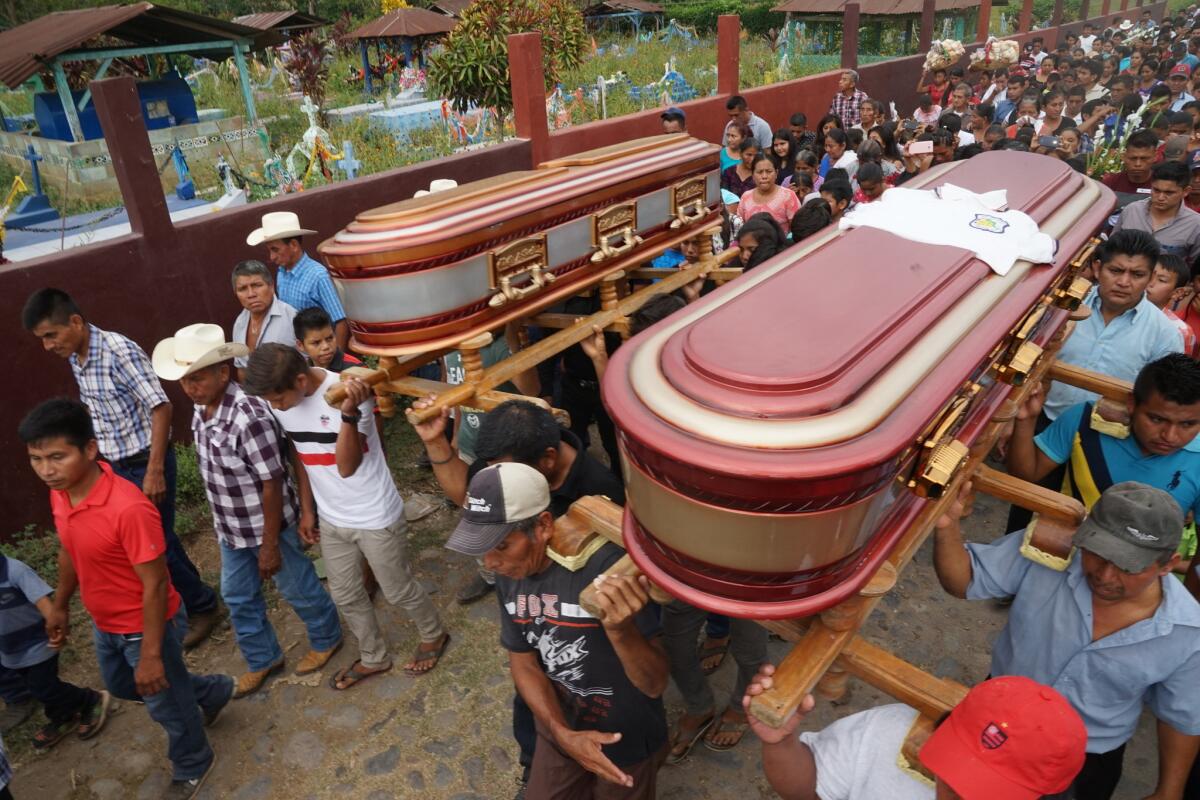
- Share via
Reporting from Aldea Nica, Guatemala — Candido Antonio Romero heard the voice as he lay trapped beneath the dead and the injured, amid the moans of pain and the pleas for help.
“Get up!” the voice shouted.
Three days earlier, Romero, his friend Carlos Hernandez and at least eight of their neighbors — all in their teens or 20s — had left the village of Nica in western Guatemala with one of the many smugglers who guide migrants to the United States.
Now, their American dream had ended with that of dozens of other migrants in an overturned truck along an isolated stretch of highway in southern Mexico.
In his half-conscious state, Romero wondered if it was all a hallucination — or if he was about to take his final breath.
The voice — perhaps a rescuer, perhaps an internal exhortation, he wasn’t sure — continued: “It’s not your time to die!”
::
A few weeks earlier, a front man for a smuggling operation had come to Nica looking for customers.
The United States had long been a way out of this impoverished agricultural hamlet of about 7,000, many of whom have relatives there.
Romero’s father lives in Michigan and has been sending money home for more than a decade to support his wife and six children. At one point, he brought back a U.S. flag, which adorns the exterior wall of the family house — one of many in town kept up with remittances.
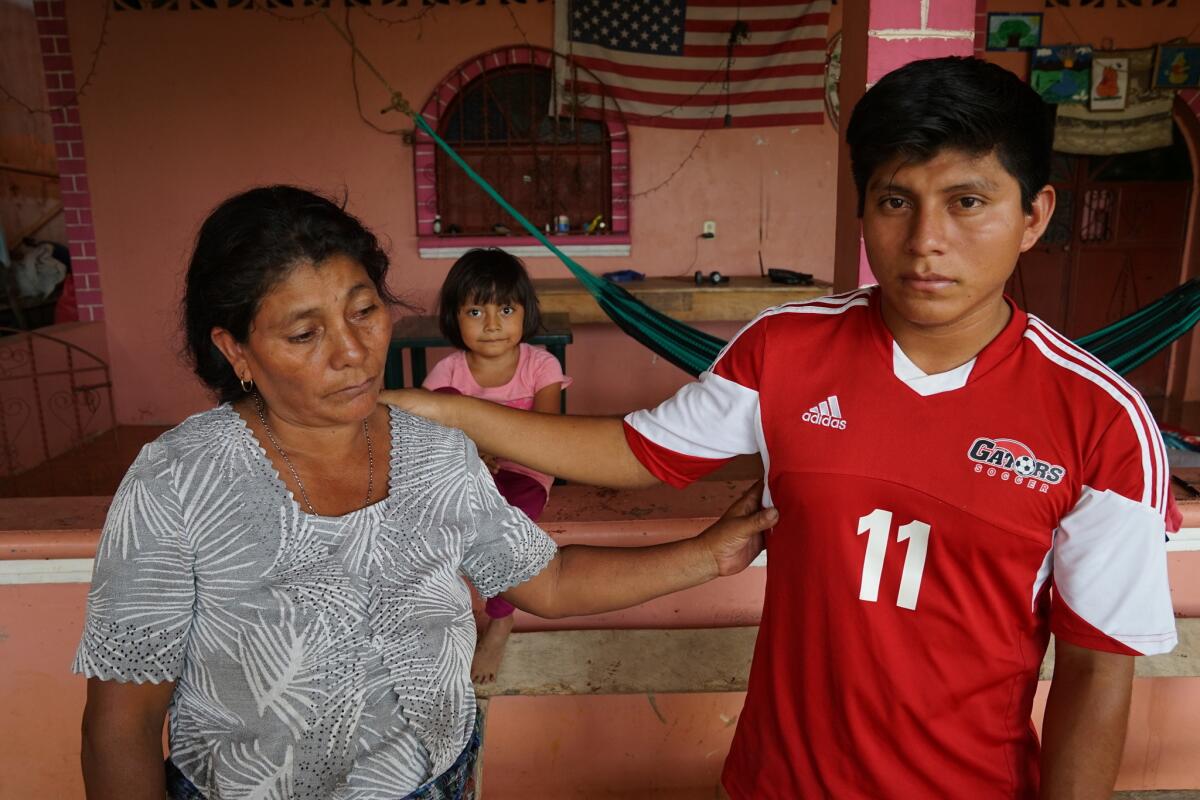
Romero, a 20-year-old unemployed mechanic, didn’t hesitate at the chance to join his father, who agreed to pay the smuggler $6,500 for the trip to Michigan.
“Mama, you’re getting older, I want to support you,” Romero told Carmen Chavez.
Hernandez, 24, the eldest of four siblings, felt an urgent need to help his family and planned to settle in Atlanta. Friends already there agreed to lend him money to pay the smuggler.
The migrants who set out from Nica on March 4 had known one another for most of their lives. They had heard enough about the smuggling networks — used by most U.S.-bound Central Americans — to know that the trip might be treacherous.
Each traveler carried a backpack with a change of clothes, water, food and other essentials.
Nica sits a few miles from the Mexican border, but the coyote explained that the group would encounter fewer Mexican police and immigration patrols if they entered Mexico about 55 miles to the north from La Mesilla, a Guatemalan border town and contraband hub.
They took public buses there, stopping for a night at a hotel. The compañeros from Nica stuck together as the group swelled with migrants from elsewhere in Guatemala.
They crossed into Mexico in the predawn hours of March 6 in several vehicles, then spent the night near the city of San Cristobal de las Casas.
The next day, about 60 men and 10 women climbed into the cargo hold of a Ford Super Duty, a 3-ton truck comparable to a midsize moving van.
The men stood, and the women sat on the floor. Hernandez used his belt to fashion a strap hanger as the truck barreled along.
Romero and Hernandez were stunned by how crowded, and hot, it was inside the truck, where there was no natural light and little air once the doors were shut.
“There was practically no room to breathe,” Hernandez recalled. “We were all on top of each other. We couldn’t see where they were taking us.”
The migrants were thrown back and forth as the truck careened through a series of curves. Fearing an accident, Hernandez took off his shirt and covered his head.
Despite a piercing headache, Romero managed to sleep fitfully for an hour.
“When I woke up I saw that the driver had lost control,” he recalled.
::
The impact forced open the truck’s doors and ejected passengers into a ditch.
It was 6:30 p.m. and already dark. Hernandez and Romero blacked out, then came to amid a battlefield-like spectacle of despair.
“We are all doing to die!” somebody shouted.
“I felt a sharp pain and I couldn’t get up,” said Hernandez, who ended up in the ditch. “I saw that all the dead were tossed around the truck. There were [injured] who were saying, ‘Help me! I don’t want to die! Please get me out.…’ There were shouts of terror, like from a nightmare.”
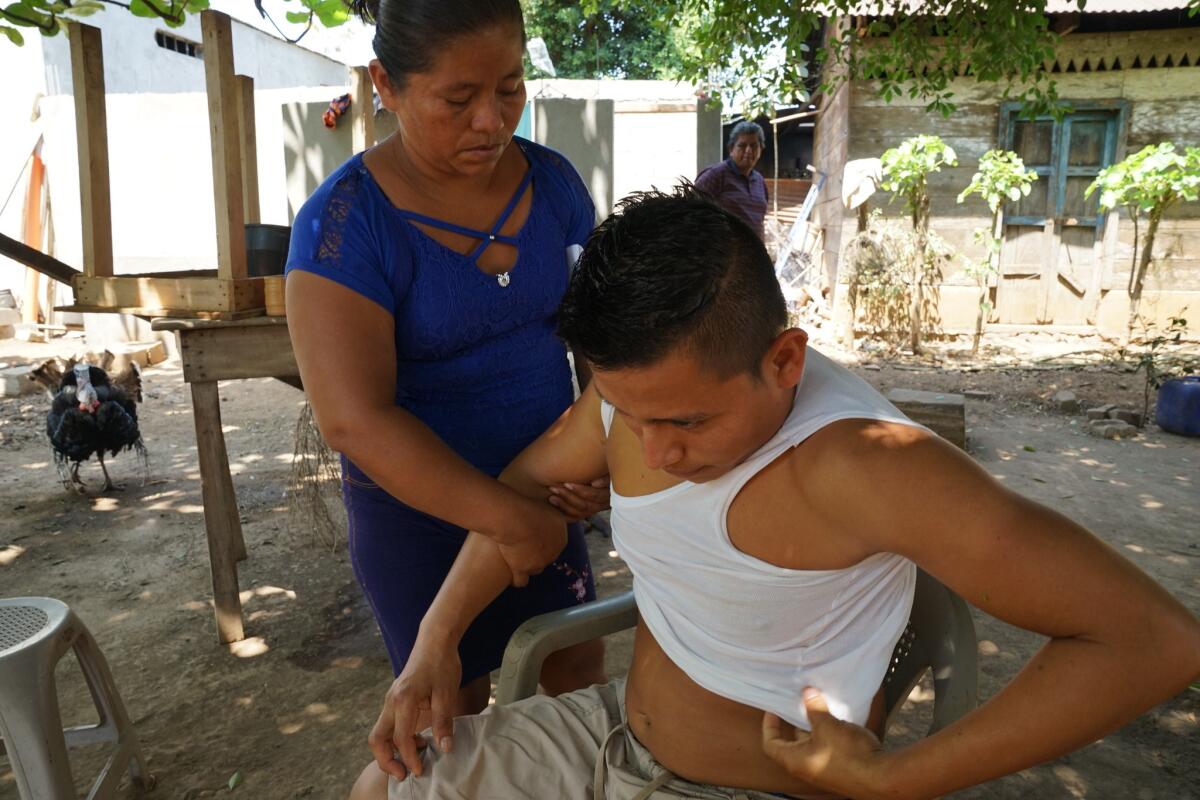
Romero thought it might all be a bad dream.
“I raised my head and began to breathe,” he recalled. “My [left] arm was hurting and I said to myself, ‘OK, if they have to cut off my arm so be it, I want to live.…’ I saw all the dead people and I began to cry for my life.”
He heeded the voice urging him to get up and spotted the bloodied, prone figure of his friend Felix Cash Lopez.
“I called to him: ‘Felix! Felix!’ … But he couldn’t talk. He was already dying from inside.”
It took volunteers about half an hour to reach the accident scene, about 30 miles northwest of San Cristobal.
Rescuers used ropes to drag the injured up the steep incline leading from the Bombana River. They placed Hernandez in an ambulance with a badly injured woman.
“It hurts! I don’t want to die!” she cried over and over before going silent.
She was dead before they reached the hospital.
In total, authorities said, the crash left 23 dead and 33 injured — all from Guatemala. Mexican authorities said they are investigating the smuggling ring, including the driver, who escaped.
Back in Nica, anxious families were starting to learn the fate of loved ones. Word spread that Hernandez and Romero had been killed.
“The neighbors came and told me, ‘Doña Hermelinda, your son died,’” recalled Hermelinda Chavez Hernandez, 40. “I was so scared, I prayed, ‘Dear God, don’t take my son.’”
But a nurse from the hospital in Mexico called and told her that her son had survived.
Hernandez was hospitalized for severe bruises on his right side and shoulder.
It took two days for Romero’s mother to learn that he was alive, though badly bruised. Neighbors who had traveled to Mexico sent word.
::
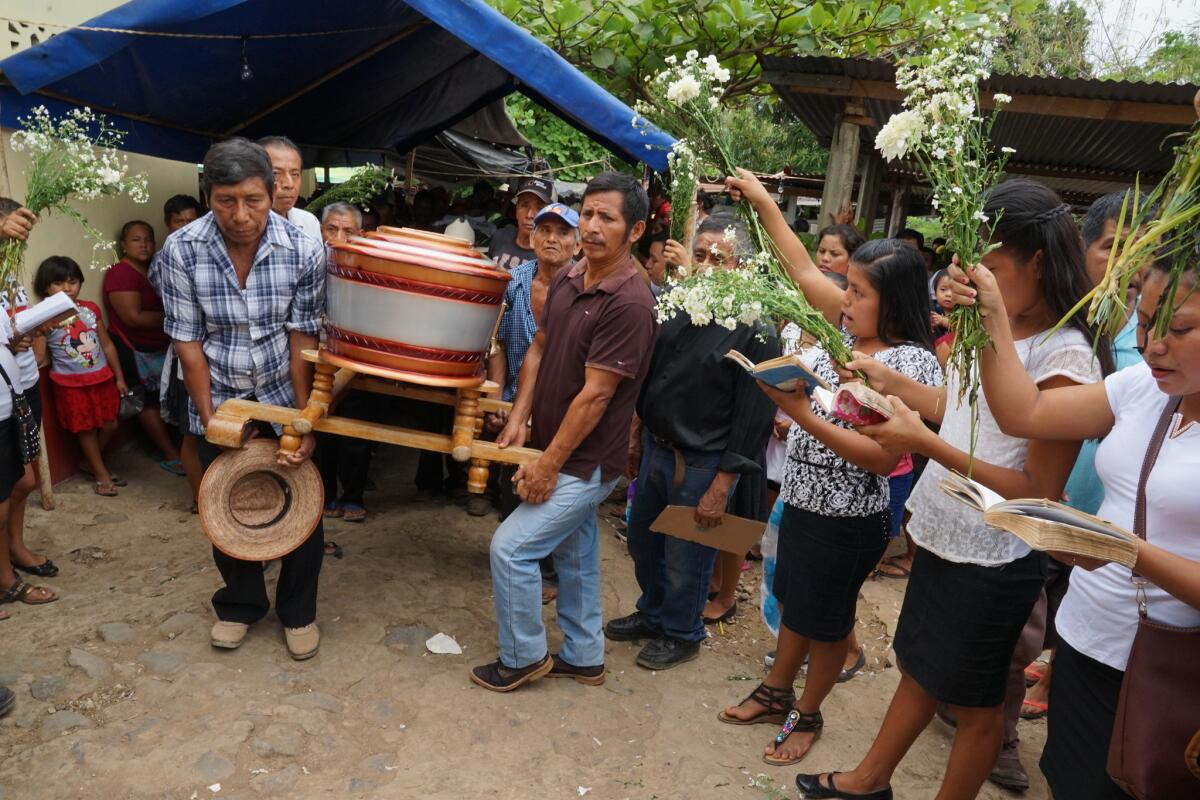
Three days after the crash, the first group of bodies arrived — five coffins jammed in a hearse. Romero and Hernandez rode in the front seat.
In all, the town lost five men and two women.
Relatives held private mourning services, displaying flower-bedecked coffins in simple backyards illuminated by candles. Some townsfolk spoke of the difficulty of persuading young people to not venture north.
“I’m holding on to my kids, but it’s not easy,” said Reina Lopez, 46, a mother of four attending a memorial service for Oscar Adan Mazariegos, 29. “Our children study, but there’s no work for them here.”
Lopez was comforting Mazariegos’ wife, Hedi Paz, 24, who was nine months pregnant. Paz was cradling her 1-year old, Oscar.
“What is she going to do now?” Lopez asked. “How will she make ends meet, a young mother with no husband?”
A few blocks away, children in school uniforms were among those saying farewell to Felix Cash Lopez, who soon would have turned 18.
He died with a 19-year-old cousin. The pair had hoped to join relatives in Atlanta, where Cash Lopez was excited about meeting his brother’s 4-month-old baby, Lesli, part of a new generation of Americans with roots in Nica.
“His dream, and mine, was to one day arrive there and hug our niece,” said his distraught sister, Loreni Magnolia Cash Lopez, 16.
Inside her brother’s coffin she placed some treasured possessions, including a plastic razor and the Barcelona soccer team’s coat of arms. Atop the casket she positioned a picture of herself with a heart alongside a photo of him.
Beneath a punishing sun, the funeral corteges wound slowly through the deep-rutted streets to the municipal cemetery, where faded paper streamers and crosses mark graves.
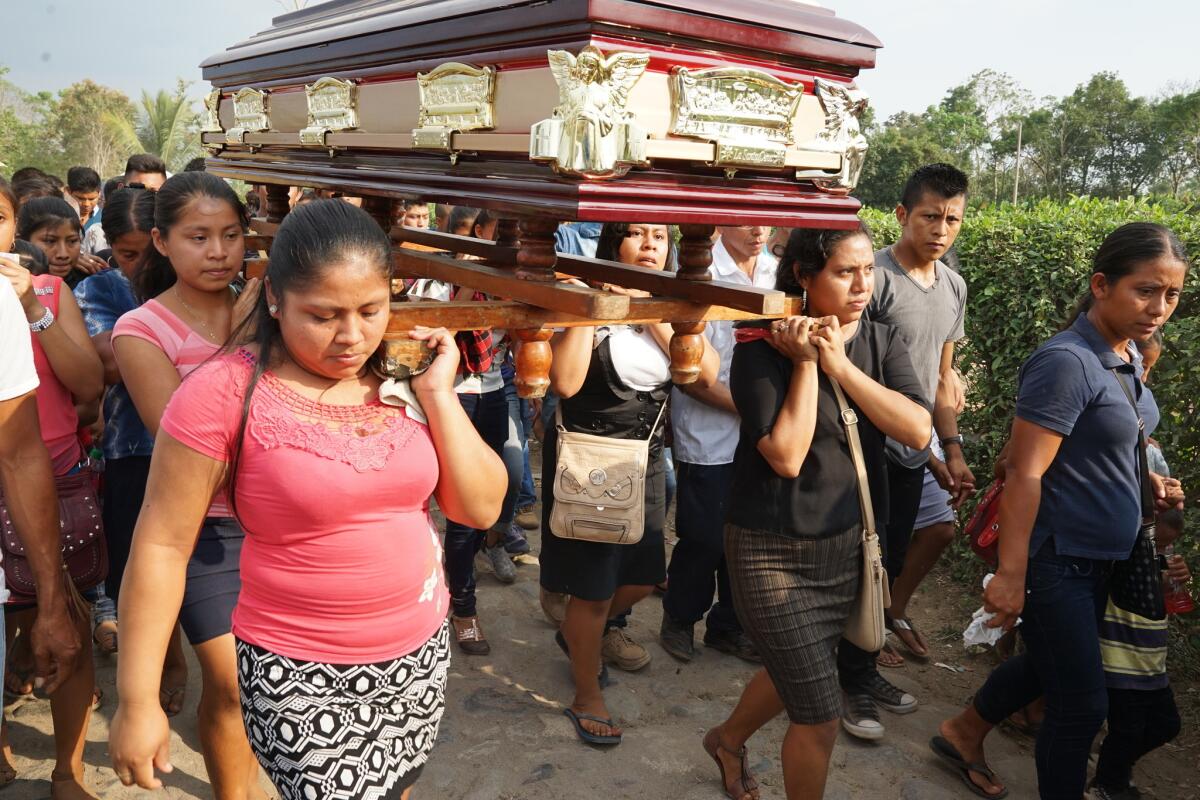
Dour-faced women helped carry the casket of Yesica Andres Perez, who was going to the United States to be with her fiance, a Nica native. She was 17.
The coffins of the two teenage cousins were hoisted amid flower-bearing mourners. A women’s choir sang from prayer books and a loudspeaker blared a lament from the soundtrack of a Guatemalan film:
I went in search of the American dream
To work and help my brothers….
But destiny did not lend me its hand
And one day, without imagining, a tragedy ended my dream.
::
Central Americans have been arriving at the U.S. border in surging numbers, despite the dangers and the strenuous efforts by the Trump administration to discourage them. No one here sees that changing.
“I say to President Trump: ‘The people of Nica and Guatemala will never stop going to the United States, no matter how many barriers you build,’” said Andres Avelino Lopez Santos, a 53-year-old mourner who spent 15 years in the U.S. and has three children there. “Necessity drives us.”
The needs here remain extensive. There is no full-time teacher at the high school. Wells are polluted, raw sewage courses through fetid streams, and residents rely on subsistence crops of corn, bean, yucca and bananas. Scrawny dogs and pigs compete with gaunt fowl for scraps of food.
The accident put an end to hopes for something better in the United States.
“I wanted to have my own house, my wife, make my life there,” Romero said outside his home here, seated on a plastic chair with the Stars and Stripes behind him.
He said he will savor his “second life” and has no intention of attempting the trip north again — a sentiment echoed by Hernandez.
“I saw death very close,” Hernandez, wincing in pain and struggling to breathe, said from the shade of an almond tree in his family backyard. “This was the first time I tried to go, but everything ended up badly.”
Special correspondent Liliana Nieto del Rio in Aldea Nica and Cecilia Sanchez of The Times’ Mexico City bureau contributed to this report.
Special correspondent Liliana Nieto del Rio in Aldea Nica and Cecilia Sanchez of The Times’ Mexico City bureau contributed to this report.
More to Read
Sign up for Essential California
The most important California stories and recommendations in your inbox every morning.
You may occasionally receive promotional content from the Los Angeles Times.










